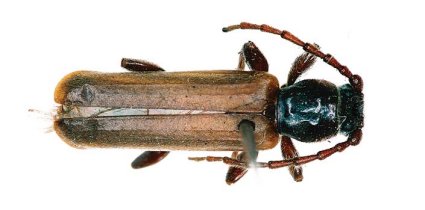Common menu bar links
Tetropium gracilicorne (Reitter) - Thin-antenna spruce borer
Coleoptera: Cerambycidae
IDENTIFICATION
Adult beetles typically have a flat black body, 8 to 18 mm long, brown or red legs and relatively thin, short, brown or red antennae (half the length of body).2, 19, 24 The 2nd through the 5th antennal segments are enlarged.24 There are different colour morphs within this species: black body, antennae and legs with light brown elytra or completely black beetles.19 The elytra have a broad covering of very fine hairs and are densely punctured.2
HOST TREES
Larix.19
LOCATION OF INFESTATION WITHIN THE TREE
Larvae feed on the inner bark and sapwood from root spurs to the top of the crown.24
HOST CONDITION
Stressed (e.g. defoliation, disease, fire, or wind), dying, and recently cut trees are preferred, but beetles also attack healthy, mature trees.19, 24, 49 Trees of all ages are attacked.24
DISTRIBUTION
Asia including Russia, Kazakhstan, northern China, northern Japan and northern Mongolia.24
SIGNS AND SYMPTOMS
Female lays eggs, often in groups of 3 to 5 in bark crevices.19, 24
Larvae form irregular shaped, longitudinal galleries (10 mm wide) first in the inner bark and then later in the sapwood. Larval galleries are filled with granular frass.19, 42 Mature larvae bore horizontally into the sapwood to a depth of 4 to 5 cm and then parallel to the wood grain for 1.6 to 2.2 cm.19, 24 These "L-shaped" galleries end in a pupal chamber. If development occurs under thick bark, larvae may only bore beneath the bark without entering the sapwood.24
Before pupation, larvae make oval emergence holes that are plugged with frass.24 Pupal chambers are lined with frass.19, 24 Pupae develop with their heads toward the holes.19
Adults emerge through these oval holes.19 External signs and symptoms include peeling bark, frass at the base of infested trees, beetles visible on the trunks, and yellowing and wilting of needles.24 Consecutive years of attack can result in tree mortality.42 When trees are not killed, infestations result in loss of vigor and reduced wood marketability due to bore holes.24

A - Adult T. gracilicorne (8-18 mm long). Note antennae are half the body length.

B - Close up of T. gracilicorne larva.

C - Start of L-shaped T. gracilicorne gallery in the sapwood.
Photo credits
